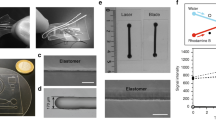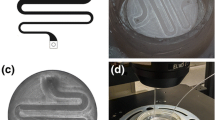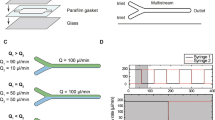Abstract
We describe a novel microfluidic perfusion system for high-resolution microscopes. Its modular design allows pre-coating of the coverslip surface with reagents, biomolecules, or cells. A poly(dimethylsiloxane) (PDMS) layer is cast in a special molding station, using masters made by photolithography and dry etching of silicon or by photoresist patterning on glass or silicon. This channel system can be reused while the coverslip is exchanged between experiments. As normal fluidic connectors are used, the link to external, computer-programmable syringe pumps is standardized and various fluidic channel networks can be used in the same setup. The system can house hydrogel microvalves and microelectrodes close to the imaging area to control the influx of reaction partners. We present a range of applications, including single-molecule analysis by fluorescence correlation spectroscopy (FCS), manipulation of single molecules for nanostructuring by hydrodynamic flow fields or the action of motor proteins, generation of concentration gradients, trapping and stretching of live cells using optical fibers precisely mounted in the PDMS layer, and the integration of microelectrodes for actuation and sensing.










Similar content being viewed by others
Abbreviations
- AC/DC:
-
Alternating current/direct current
- AMPPNP:
-
Adenosine 5′-(β,γ-imido)triphosphate
- ASE:
-
Advanced silicon etching
- ATP:
-
Adenosine 5′-triphosphate
- cDNA:
-
Complementary (or copy) DNA
- DNA:
-
Deoxyribonucleic acid
- ECM:
-
Extracellular matrix
- FCS:
-
Fluorescence correlation spectroscopy
- FITC:
-
Fluoresceine isothiocyanate
- FN:
-
Fibronectin
- FRET:
-
Fluorescence resonance energy transfer
- GFP:
-
Green fluorescent protein
- Hz:
-
Hertz (s−1)
- kbp:
-
Kilobase pairs
- μTAS:
-
Micro total analysis system
- nDEP:
-
Negative dielectrophoresis
- nM:
-
Nanomol/liter
- nN:
-
Nanonewton
- OD:
-
Outer diameter
- PCB:
-
Printed circuit board
- PDMS:
-
Poly(dimethylsiloxane)
- PMMA:
-
Poly(methylmethacrylate)
- PNIPAAm:
-
Poly(N-isoproypyl acrylamide)
- POMA:
-
Poly(octadecene-alt-maleic anhydride)
- PTFE:
-
Poly(tetrafluoroethylene)
- RNA:
-
Ribonucleic acid
- TIRF:
-
Total internal reflection fluorescence
- UNF:
-
Universal National Fine Thread
References
Allemand JF, Bensimon D, Jullien L, Bensimon A, Croquette V (1997) pH-dependent specific binding and combing of DNA. Biophys J 73:2064–2070
Alon R, Feigelson S (2002) From rolling to arrest on blood vessels: leukocyte tap dancing on endothelial integrin ligands and chemokines at sub-second contacts. Semin Immunol 14:93–104
Andersson H, van den Berg A (2003) Microfluidic devices for cellomics: a review. Sens Actuators B Chem 92:315–325
Böhm KJ, Stracke R, Baum M, Zieren M, Unger E (2000) Effect of temperature on kinesin-driven microtubule gliding and kinesin ATPase activity. FEBS Lett 466:59–62
Braun E, Eichen Y, Sivan U, Ben-Yoseph G (1998) DNA-templated assembly and electrode attachment of a conducting silver wire. Nature 391:775–778
Brunner C, Ernst KH, Hess H, Vogel V (2004) Lifetime of biomolecules in polymer-based hybrid nanodevices. Nanotechnology 15:S540–S548
Cesaro-Tadic S, Dernick G, Juncker D, Buurman G, Kropshofer H, Michel B, Fattinger C, Delamarche E (2004) High-sensitivity immunoassays for tumor necrosis factor α using microfluidic systems. Lab Chip 4:563–569
Dertinger SKW, Chiu DT, Li Jeon N, Whitesides GM (2001) Generation of gradients having complex shapes using microfluidic networks. Anal Chem 73:1240–1246
Dertinger SKW, Jiang X, Li Z, Murthy VN, Whitesides GM (2002) Gradients of substrate-bound laminin orient axonal specification of neurons. Proc Natl Acad Sci USA 99:12542–12547
Diez S, Reuther C, Dinu C, Seidel R, Mertig M, Pompe W, Howard J (2003) Stretching and transporting DNA molecules using motor proteins. Nano Lett 3:1251–1254
Dittrich PS, Schwille P (2003) An integrated microfluidic system for reaction, high-sensitivity detection, and sorting of fluorescent cells and particles. Anal Chem 75:5767–5774
Dittrich PS, Müller B, Schwille P (2004) Studying reaction kinetics by simultaneous FRET and cross-correlation analysis in a miniaturized continuous flow reactor. Phys Chem Chem Phys 6:4416–4420
Dittrich PS, Jahnz M, Schwille P (2005) A new embedded process for compartmentalized cell-free protein expression and on-line detection in microfluidic devices. ChemBioChem 6:811–814
Duschl C, Geggier P, Jäger M, Stelzle M, Müller T, Schnelle T, Fuhr G (2004) Versatile chip-based tools for the controlled manipulation of microparticles in biology using high frequency electromagnetic fields. In: Andersson H, van den Berg A (eds) Lab-on-chips for cellomics: micro and nanotechnologies for life science. Springer, Berlin Heidelberg New York
Eigen M, Rigler R (1994) Sorting single molecules: application to diagnostics and evolutionary biotechnology. Proc Natl Acad Sci USA 91:5740–5747
Elson EL (1988) Cellular mechanics as an indicator of cytoskeletal structure and function. Annu Rev Biophys Biophys Chem 17:397–430
Fiedler S, Hagedorn R, Schnelle T, Richter E, Wagner B, Fuhr G (1995) Diffusional electrotitration: generation of pH gradients over arrays of ultramicroelectrodes detected by fluorescence. Anal Chem 67:820–828
Fu AY, Spence C, Scherer A, Arnold FH, Quake SR (1999) A microfabricated fluorescence-activated cell sorter. Nat Biotechnol 17:1109–1111
Georgiou G (2001) Analysis of large libraries of protein mutants using flow cytometry. Adv Protein Chem 55:293–315
Grier DG (2003) A revolution in optical manipulation. Nature 424:810–816
Guck J, Ananthakrishnan R, Moon TJ, Cunningham CC, Käs J (2000) Optical deformability of soft biological dielectrics. Phys Rev Lett 84:5451–5454
Guck J, Ananthakrishnan R, Mahmood H, Moon TJ, Cunningham CC, Käs J (2001) The optical stretcher: a novel laser tool to micromanipulate cells. Biophys J 81:767–784
Guck J, Schinkinger S, Lincoln B, Wottawah F, Ebert S, Romeyke M, Lenz D, Erickson HM, Ananthakrishnan R, Mitchell D, Käs J, Ulvick S, Bilby C (2005) Optical deformability as inherent cell marker for testing malignant transformation and metastatic competence. Biophys J 88:3689–3698
Hess H, Clemmens J, Qin D, Howard J, Vogel V (2001) Light-controlled molecular shuttles made from motor proteins carrying cargo on engineered surfaces. Nano Lett 1:235–239
Hess H, Howard J, Vogel V (2002a) A piconewton forcemeter assembled from microtubules and kinesins. Nano Lett 2:1113–1115
Hess H, Clemmens J, Howard J, Vogel V (2002b) Surface imaging by self-propelled nanoscale probes. Nano Lett 2:113–116
Howard J (2001) Mechanics of motor proteins and the cytoskeleton. Sinauer Associates, Sunderland
Huang H, Kamm RD, Lee RT (2004) Cell mechanics and mechanotransduction: pathways, probes, and physiology. Am J Physiol Cell Physiol 287:C1–C11
Knoblauch M, Peters WS (2004) Forisomes, a novel type of Ca2+-dependent contractile protein motor. Cell Motil Cytoskeleton 58:137–142
Knoblauch M, Noll GA, Müller T, Prüfer D, Schneider-Hüther I, Scharner D, van Bel JE, Peters WS (2003) ATP-independent contractile proteins from plants. Nat Mater 2:600–603
Kobayashi J, Mori Y, Okamoto K, Akiyama R, Ueno M, Kitamori T, Kobayashi S (2004) A microfluidic device for conducting gas-liquid-solid hydrogenation reactions. Science 304:1305–1308
Lärmer F, Schilp A (1994) Method of anisotropically etching silicon. US Patent No. 5501893, German Patent DE4241045
Larson RG, Perkins TT, Smith DE, Chu S (1997) Hydrodynamics of a DNA molecule in a flow field. Phys Rev E 55:1794–1797
Li Jeon N, Dertinger SKW, Chiu DT, Choi IS, Stroock AD, Whitesides GM (2000) Generation of solution and surface gradients using microfluidic systems. Langmuir 16:8311–8316
Lincoln B, Erickson HM, Schinkinger S, Wottawah F, Mitchell D, Ulvick S, Bilby C, Guck J (2004) Deformability-based flow cytometry. Cytometry 59A:203–209
Lipman EA, Schuler B, Bakajin O, Eaton WA (2003) Single-molecule measurement of protein folding kinetics. Science 301:1233–1235
Madge D, Elson E, Webb WW (1972) Thermodynamic fluctuations in a reacting system—measurement by fluorescence correlation spectroscopy. Phys Rev Lett 29:705–708
Manz A, Graber N, Widmer HM (1990) Miniaturized total chemical analysis systems: a novel concept for chemical sensing. Sens Actuators B Chem 1:244–248
Manz A, Fettinger JC, Verpoorte E, Lüdi H, Widmer HM, Harrison DJ (1991) Micromachining of monocrystralline silicon and glass for chemical analysis systems: a look into next century’s technology or just a fashionable craze? Trends Anal Chem 10:144–149
Maubach G, Csáki A, Seidel R, Mertig M, Pompe W, Born D, Fritzsche W (2003) Controlled positioning of a DNA molecule in an electrode setup based on self-assembly and microstructuring. Nanotechnology 14:1055–1056
Mertig M, Pompe W (2004) Biomimetic fabrication of DNA-based metallic nanowires and networks. In: Niemeyer CM, Mirkin CA (eds) Nanobiotechnology: concepts, applications and perspectives. Wiley-VCH, Weinheim, pp 256–277
Mertig M, Colombi Ciacchi L, Seidel R, Pompe W, De Vita A (2002) DNA as a selective metallization template. Nano Lett 2:841–844
Müller T, Gradl G, Howitz S, Shirley S, Schnelle T, Fuhr G (1999) A 3-D microelectrode system for handling and caging single cells and particles. Biosens Bioelectron 14:247–256
Pompe T, Zschoche S, Herold N, Salchert K, Gouzy MF, Sperling C, Werner C (2003) Maleic anhydride copolymers—a versatile platform for molecular biosurface engineering. Biomacromolecules 4:1072–1079
Prots I, Stracke R, Unger E, Böhm KJ (2003) Isopolar microtubule arrays as a tool to determine motor protein directionality. Cell Biol Int 27:251–253
Richter J, Mertig M, Pompe W, Mönch I, Schackert HK (2001) Construction of highly conductive nanowires on a DNA template. Appl Phys Lett 78:536–538
Richter A, Kuckling D, Howitz S, Gehring T, Arndt KF (2003) Electronically controlled microvalves based on smart hydrogels: magnitudes and potential applications. J Microelectromech Syst 12:748–753
Richter A, Howitz S, Kuckling D, Arndt KF (2004) Influence of volume phase transition phenomena on the behavior of hydrogel-based valves. Sens Actuators B Chem 99:451–458
Ruardy TG, Schakenraad JM, van der Mei HC, Busscher HJ (1997) Preparation and characterization of chemical gradient surfaces and their application for the study of cellular interaction phenomena. Surf Sci Rep 29:3–30
Schinkinger S, Wottawah F, Travis KA, Lincoln B, Guck J (2004) Feeling for cells with light. Proc SPIE Optical Trapping Optical Micromanipulation 5514:170–178
Schnapp BJ, Crise B, Sheetz MP, Reese TS, Khan S (1990) Delayed start-up of kinesin-driven microtubule gliding following inhibition by adenosine 5′-[β,γ-imido]triphosphate. Proc Natl Acad Sci USA 87:10053–10057
Scholey JM (1993) Motility assays for motor proteins (Methods in cell biology, vol 39). Academic Press, San Diego
Seeman NC (1996) The design and engineering of nucleic acid nanoscale assemblies. Curr Opin Struct Biol 6:519–526
Stracke P, Böhm KJ, Burgold J, Schacht HJ, Unger E (2000) Physical and technical parameters determining the functioning of a kinesin-based cell-free motor system. Nanotechnology 11:52–56
Van Vliet KJ, Bao G, Suresh S (2003) The biomechanics toolbox: experimental approaches for living cells and biomolecules. Acta Materialia 51:5881–5905
Wirtz D (1995) Direct measurement of the transport properties of a single DNA molecule. Phys Rev Lett 75:2436–2439
Wottawah F, Schinkinger S, Lincoln B, Ananthakrishnan R, Romeyke M, Guck J, Käs J (2005) Optical rheology of biological cells. Phys Rev Lett 94:098103
Yan H, Park SH, Finkelstein G, Reif JH, LaBean T (2003) DNA-templated self-assembly of protein arrays and highly conductive nanowires. Science 301:1882–1884
Zimmermann RM, Cox EC (1994) DNA stretching on functionalized gold surfaces. Nucleic Acids Res 22:492–497
Acknowledgements
We thank G. Fuhr (Fh-IBMT) and G. Gradl (Evotec Technologies GmbH, Berlin) and their coworkers for cooperation in the field of nDEP and cell sorting, M. Knoblauch (Fh-IME, Aachen) for the supply of forisomes, W. Pompe (TU Dresden) and J. Howard (MPI-CBG Dresden) for useful discussions on nanostructuring, and C. Wenzel and K. Richter (TU Dresden) for their help with ASE. This work was funded by Grants from the German Ministry of Education, Science, Research, and Technology (BMBF) (Grant No. 0314025 and 0314036), the Deutsche Forschungsgemeinschaft (FOR 335), the Saxonian Ministry of Science and Arts (SMWK), and the Sächsische Aufbaubank (SAB) (Grant No. 6988/1099 and 9890/1519).
Author information
Authors and Affiliations
Corresponding author
Rights and permissions
About this article
Cite this article
Gast, F.U., Dittrich, P.S., Schwille, P. et al. The microscopy cell (MicCell), a versatile modular flowthrough system for cell biology, biomaterial research, and nanotechnology. Microfluid Nanofluid 2, 21–36 (2006). https://doi.org/10.1007/s10404-005-0047-6
Received:
Accepted:
Published:
Issue Date:
DOI: https://doi.org/10.1007/s10404-005-0047-6




